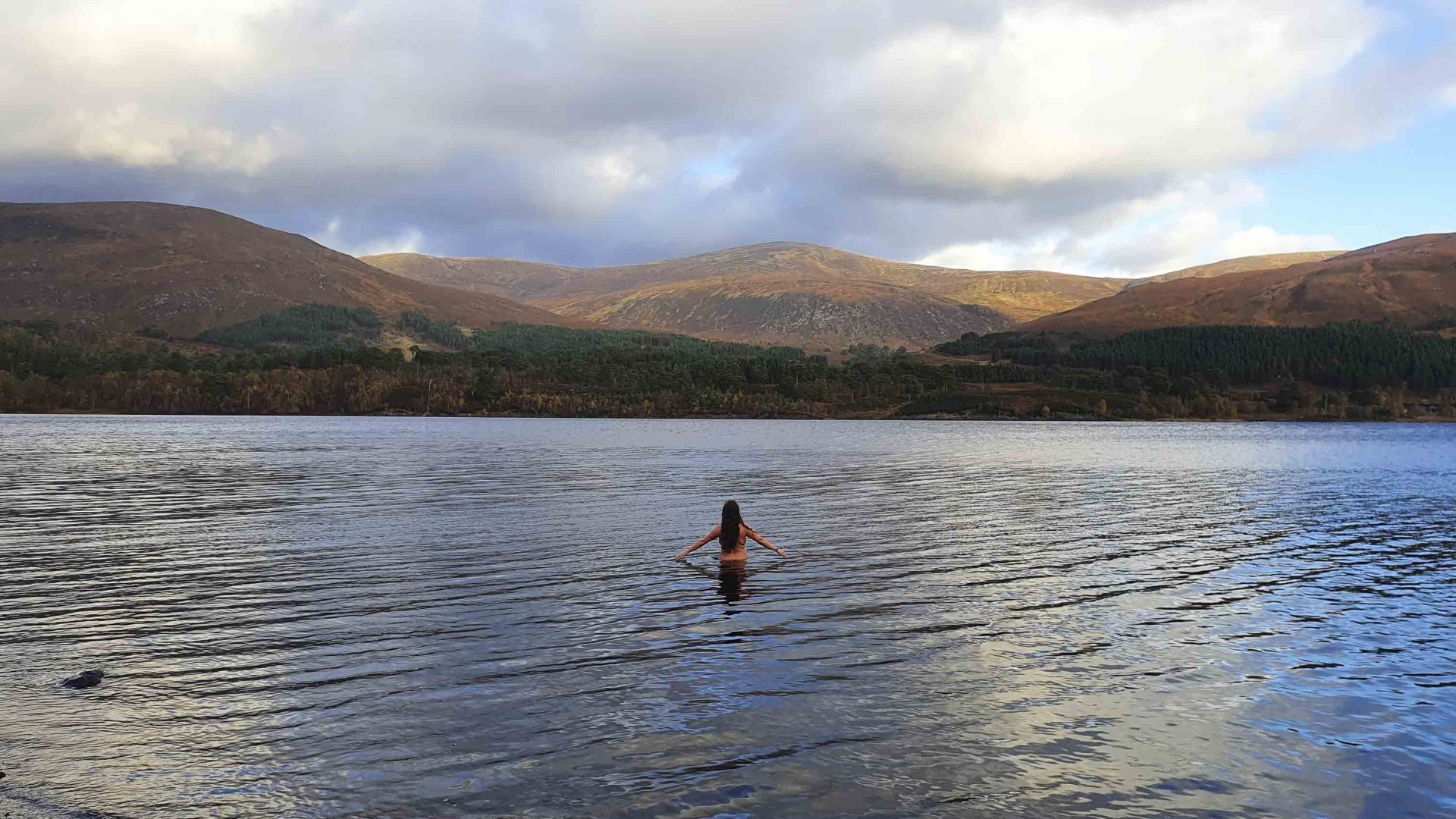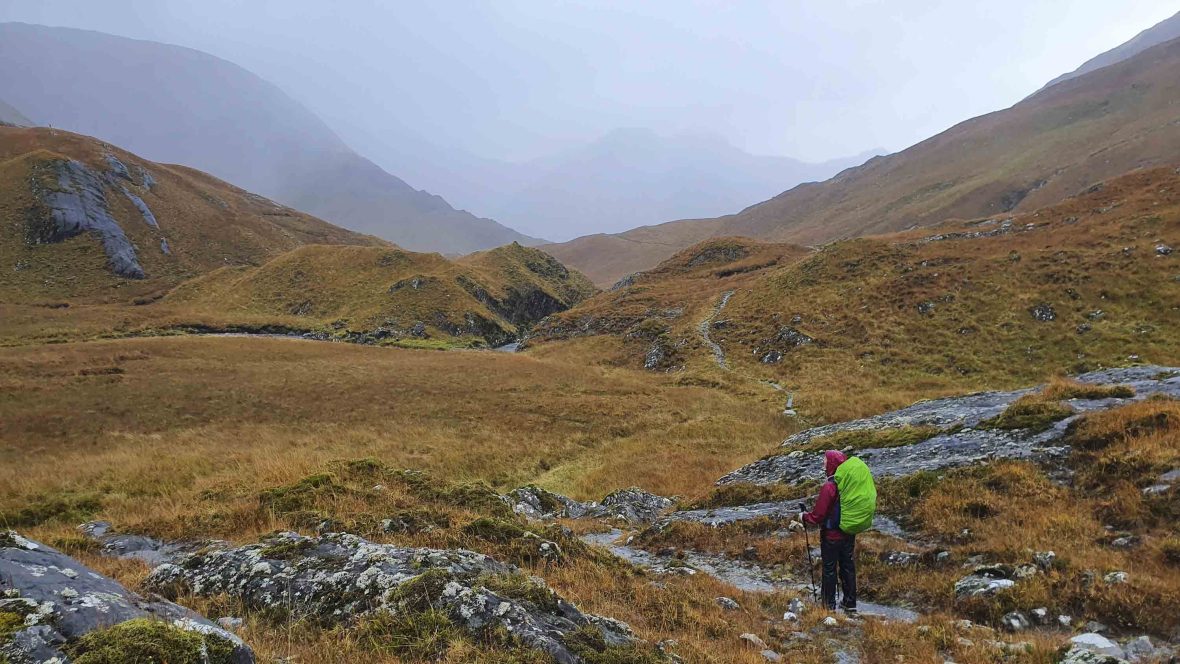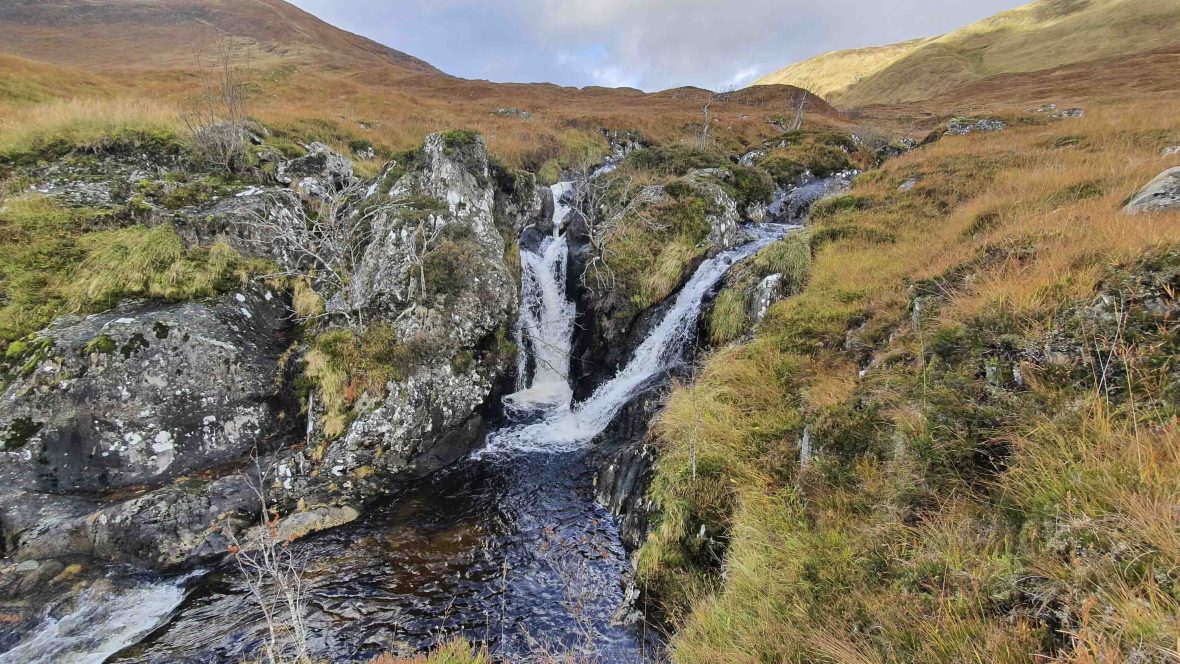
On the Affric Kintail Way in Scotland, writer Brooke Nolan questions why we have a culture of pushing ourselves to the extreme on the trail and comes to peace with the idea of giving “easy” a go.


On the Affric Kintail Way in Scotland, writer Brooke Nolan questions why we have a culture of pushing ourselves to the extreme on the trail and comes to peace with the idea of giving “easy” a go.
With each step, the water squelches between my toes and drips from the peak of my hood, splashing into my eyes. I’ve long since given up trying to stay dry.
Even my carefully-chosen-for-Scottish-weather waterproof trousers, bomb-proof jacket and Goretex boots can’t save me from the relentless rain that has followed us like a shadow for the past 48 hours. It is a distinct change from the unseasonably warm October weather that blessed us for the first two days of our hike.
The Affric Kintail Way (AKW) is a 44-mile (71-kilometer) hiking trail that stretches from Drumnadrochit on Loch Ness to Morvich in Kintail, in the southwest corner of the Scottish Highlands. Usually completed over four days and three nights, we’d planned to spend an extra night on the trail, camping a few kilometers from the end of the track.
But now, the prospect of setting up tents in this weather gives us chills colder than the water trickling down the back of our necks. So instead, we decide to call it a day and trade our sodden tents for the warming comfort of a Scottish pub fire, bangers and mash, and a pint of ale.
We’re taking the easy option—something that I used to avoid. But on this hike, I have truly embraced ease for the first time.

Hiking is deeply ingrained in Scottish culture and traditions, and the AKW is a fairly new addition to the country’s long-distance trail repertoire, opening in 2015. After two days meandering along forestry trails, it reaches the otherworldly Glen Affric.
A glen is, in other terms, a valley. These valleys are a testament to the force of mother nature—their deep, shadowy contours carved by mighty glaciers. As the last ice age ended 11,500 years ago, the glaciers retreated, leaving behind a landscape steeped in enchantment and mystery.
I can’t stop comparing myself to the old me—who, while never the strongest or fastest, relished a challenge.
Glen Affric is often described as the most beautiful glen in Scotland. And, having spent days in its company, it’s easy to see why.
This is a fascinating landscape where the ethereal beauty of native forests, shimmering lochs, and misty moorland come together in perfect harmony. Hiking in the heart of autumn has rewarded us with a wild and empty landscape—a rich tapestry of reds, yellows, oranges and golds punctuated by lush greens.
Part of the dramatic appeal of Glen Affric is the Munros (mountains of 3,000 feet—914 meters— or more in height) that tower above in every direction. These peaks are some of the most challenging to climb in Scotland. Their names include Mam Soul, Carn Eige, Sgurr nan Ceathreamhnan, Ben Attow, and the Five Sisters. It’s a Scottish pastime to climb as many Munros as possible—hiking off-trail and completing the objective fully self-supported. That means carrying your own food, water, supplies and yourself by foot.
As someone who has completed multi-day hikes in multiple countries, climbed Mt. Toubkal in Morocco and skied across an Arctic Plateau, I figured that climbing a few Munros would appeal deep within my soul. But instead, I am following a well-mapped and graded trail with plenty of signage with a more-than-doable total of 6,000 feet (1,828 meters) of elevation over the entire distance. And, to really keep it cush for our standards, we’ve even taken a whole extra day longer than the suggested route.
So what’s changed? As we stroll along the trail, this question plays over and over in my mind. And the words I use with myself are not kind. Why are you so lazy? What’s wrong with you? I can’t stop comparing myself to the old me—who, while never the strongest or fastest, relished a challenge.
The ‘old’ me would have wanted to reach every summit, to get off the beaten path, to climb—or at least attempt to climb—the Munros that surround me. But now, I am happy in their foothills. I am happy that instead of slogging up hills and navigating by map and compass, we are following a path that is as obvious as it is flat. I am happy that instead of rushing to set up camp in the dark after a long, exhausting day, we are setting up camp mid-afternoon, chatting and laughing as we share dinner, read books, and watch the sunset.
Yet, despite knowing it’s what I want, it feels wrong. I should want to work hard, to push myself. I am somehow failing by not living up to my own expectations or doing justice to my past adventures.
But since COVID-19, truthfully, my appetite for adventure has changed. It’s like those 11 months I spent in lockdown replaced my desire for extreme with the desire for simplicity. A desire to simply be in nature rather than challenge it. And although it’s been three years since the pandemic started, I’m not back to my old self yet, no matter how much I wish I were.
When I took away the pressure of what I thought an adventure should be, I was constantly amazed by the beauty of the landscape and the rich history and community woven into every step of the trail.
As the kilometers slowly pass by, I remember the saying ‘comparison is the thief of joy’. It echoes with every footstep, and I realize how silly it is to be here in this magical place, yet wishing I had the energy and drive to do it differently. I decide to let it go. I choose to embrace ease.
When you remove challenge from outdoor adventure, you’re left with two things: Nature and plenty of time to appreciate it.
Instead of rushing up Munros in the driving rain, we stop mid-morning to swim naked in a deserted loch, the rain on our faces warm compared to the biting cold of the icy water. We witness not one, not two, but three rainbows, each more breathtaking than the last. Each time we pause, not just for a quick photo, but to truly admire each in their relentless glory.
My friend Eve and I make friends with a solo hiker named Vanessa and spend an afternoon and night in Camban bothy, an ancient stone shelter built in the 1900s and renovated in 1969. Its solid stone walls and wooden bunks may be basic, but they feel luxurious to hikers.
As wild winds and rain hammer against the door, we sip hot chocolate by candlelight and share stories that, in other environments, would take years to build up the rapport to comfortably share.
We even take a detour to Cannich Stores, home to ‘the best chips in the world’ according to my hiking friends who had been dreaming of them since their last trip to the area, where they summited three Munros in a day. With nowhere to rush to, we spend ages chatting to the owners, realizing they used to live 15,000 kilometers away in Australia, in the very same village I now call home.

It turns out that when I am able to take away the pressure of what I thought an adventure should be, I am constantly amazed by the beauty of the landscape and the rich history and community woven into every step of the trail. It’s a reminder that sometimes the most rewarding adventures are those that take you on a journey through time as well as space.
I’m learning that ‘easy’ adventures can be just as valuable as more difficult challenges but in different ways. They offer the chance to slow down, connect with the landscape, and appreciate the simple beauty of the world around us. I’m leaving Glen Affric with a newfound appreciation for the meaning of adventure and the importance of embracing change. It’s a funny thing to discover that the true challenge that thrills me these days is the challenge of doing what I haven’t in the past.




Can't find what you're looking for? Try using these tags: